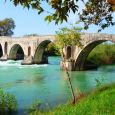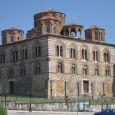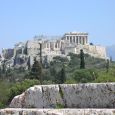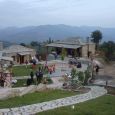Arta
Advertisement
By Air
Airports nearest to Arta are sorted by the distance to the airport from the city centre.
Preveza Airport (distanced approximately 32 km)
Ioannina Airport (distanced approximately 61 km)
Agrinion Airport (distanced approximately 70 km)
Kerkyra Airport (distanced approximately 100 km)
Araxos Airport (distanced approximately 120 km)
By Bus
Regular bus lines connect Arta with all bigger Greek cities.(bus to Athens departs several times a day and trip takes about 5 hours).
By Road
Arta is located NNW of Antirrio, Messolongi and Agrinio, NE of Preveza, SSE of Ioannina and nearly SW of Trikala.The city is linked with the GR-5 (Antirrio-Ioannina) and the GR-30 which links with Peta and Trikala.The Arachthos River flows to the west with its reservoir lying directly to the north.
Advertisement
Church of the Paregoretissa
The Church of the Paregoretissa is the 13th-century Byzantine metropolitan church of the Greek city of Arta.Part of the building houses the Archaeological Collection of Arta.The church was founded in ca.1290 by the Despot of Epirus, Nikephoros I Komnenos Doukas (r.1268–1297), and his second wife Anna Kantakouzene.The church eventually became bankrupt, and was turned into a dependency (metochion) of the Monastery of Kato Panagia.In 1578, it is attested as a female convent.The church is a large, almost square three-storey building.It is of the octagonal type, with the central dome supported by eight piers divided into three tiers.There are also four smaller domes on each corner of the church's flat roof, and a lantern.
St. Theodora Arta Church
The original church was founded in honor of St. George.But today celebrates St. Theodora of Arta, the queen and patron of linking the past, present and future of the city.The original church was built in the 11th century.in the form of the basilica.In 1270 the Queen Theodora restored the church, which functioned as a nunnery, and added the narthex and two gables.In the 13th century.added the exonarthex both pessostiriktoi paranarthikes.The queen Theodora after the death of her husband lived in the monastery until the end of her life.Excellent and interesting relics housed in the temple.The portable image Cretan school of Christ, which dates from 1653 and is the work of metalsmithing Tsimouris Ath.Two beautiful silver urns, embossed decoration, containing the relics of Saint Theodora.Finally argyrependyti the big picture of the Holy, the work of 17th century., Whose painting was on thin layer of gold.
Archaeological Museum of Arta
The Archaeological Museum of Arta is a museum in Arta, Greece.It was established in 1973 as the Archaeological collection of Arta, and has been housed in the Trapeza (dining room) of the 13th-century Paregoretissa church.It was established as a full museum in 2009.The exhibition includes three main sections: the public life, the cemeteries, and the private life of Ambraciotes, whilst at the start and end of the exhibition there are individual smaller sections covering the birth and fall of Ambracia, respectively.The museum's exhibition spans a wide time period, from the Paleolithic up to the Roman period.The majority of exhibits belongs to the Hellenistic era, an era that coincides with the highest economical and civil growth in the heyday of Ambracia at which time the city was the capital of Epirus.
Kato Panagia Monastery
The Holy Monastery of the Virgin Birth or route of vryseos as previously mentioned in the sources, is built at the foot of the hill Peranthi, about 20 minutes west of Arta, in an idyllic location beside the River Arachthos.Founded in 1250 by the despot of Epirus Michael II Doukas and his wife, later Saint, Theodora (feast day March 11).Its establishment coincides with the period flourished the Domain of Epirus.From the original building complex survives only universal, cross-shaped church stunning architecture, elaborate decoration with ceramic blocks and built of marble taken from the ruins of the neighboring Amvrakias the west outer side of which is clearly the monogram of Michael Doukas, Despot of Epirus during the years 1237-1270.The church is painted in various ancient periods that the deacon carried as a modern structure, ie the mid- 13th century.Regarding the cells and other auxiliary buildings are later.
The bridge of Arta
is a stone bridge over the River Arachthos, 17th century AD, the town of Arta made famous by the legendary namesake folk song which refers to "human sacrifice on" the foundation.The same condition is also a modern metaphor when referring to projects that are slow to complete as in the legend of the song ("All day long the building, the evening egkremizotan").The stone bridge of Arta, is the most famous in Greece and it certainly owes to the legend of the "sacrifice of his wife's master builder," the muse made him popular song.The original construction of the bridge placed in the years of classical Amvrakias on King Pyrrhus A.This is natural since in these places a considerable civilization from pre-Christian even years.
February - March
Information not available
Advertisement








